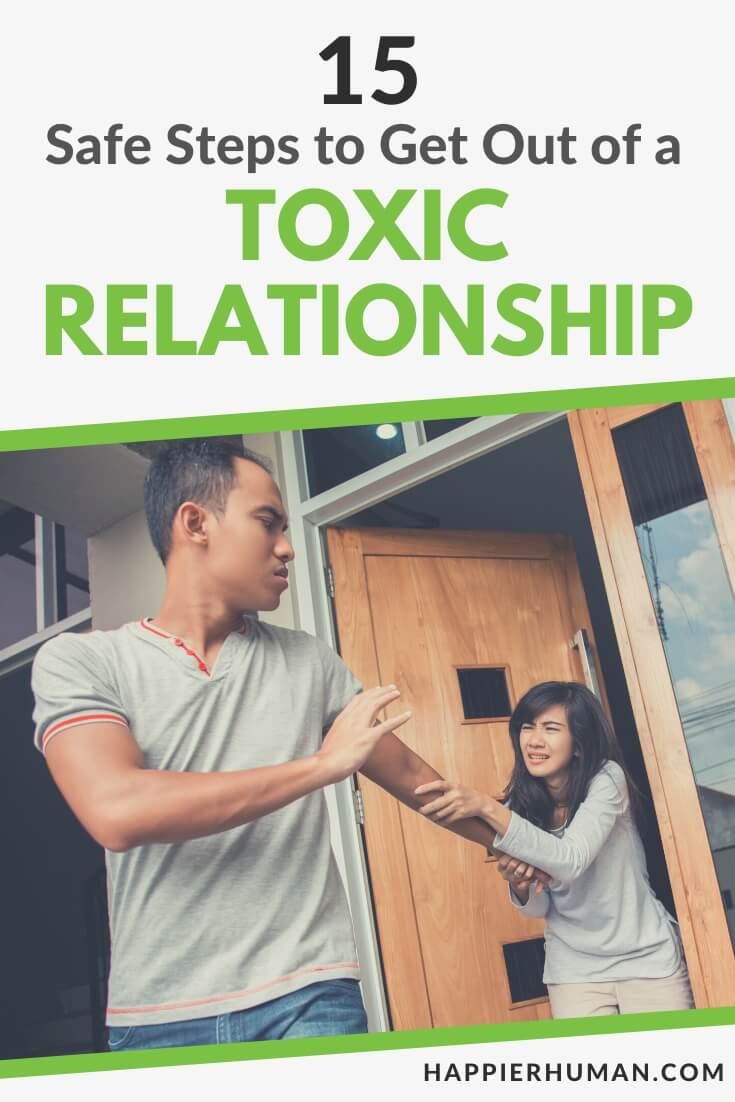Every day, someone somewhere is confronted with the question of how to get out of a toxic relationship. Been there, done that, and then found myself in another unhealthy relationship. It wasn’t until I armed myself with tips on how to break the cycle that I was able to build healthier relationships in all areas of life.
Today, I’m here to share 15 of those tips in hopes that you will use them to do the same. The primary focus isn’t just on getting out, but on doing so SAFELY. Your safety is of the utmost importance if you’re in an abusive relationship, especially one that may involve physical violence.
Keep safety at the forefront of your mind also if your partner struggles with other disruptive/maligned personality traits such as those seen in people with disorders such as narcissistic personality disorder (NPD), borderline personality disorder (BPD), and psychopathy.
Before delving in, I’ll explain what a toxic relationship looks like, why some people keep attracting toxic partners, and the health effects of toxic relationships.
What Is a Toxic Relationship?
Your relationship may be toxic if it’s one that causes you to feel unhappy, unsupported, belittled, misunderstood, or worthless most of the time. These feelings are a threat to your physical and mental health. In such relationships, there’s usually a lack of healthy communication, honesty, trust, and openness. Those factors easily cause conflict to arise.
Dr. Lilian Glass, author of the 1995 book Toxic People, said the relationship is also one where “…one [partner] seeks to undermine the other, where there’s competition, where there are disrespect and a lack of cohesiveness.”
The relationship becomes even more toxic and dangerous when there are physically abusive behaviors such as physical aggression and fights. Similarly, abusive behaviors such as psychological manipulation and threats to harm change an otherwise healthy relationship into one that’s harmful.
Why Causes Someone to Keep Getting Into Toxic Relationships?
Some people gravitate to toxic partners without realizing it. If you found yourself in several toxic or dysfunctional relationships throughout the history of your romantic relationships, there’s an explanation for it.
According to Talk Space, a person may be more prone to this type of romantic dynamic due to unresolved emotional trauma. Other risk factors include addiction (drug, alcohol, etc) or coming from a dysfunctional home.
*A therapist may be the best person to help you understand what’s driving the unhealthy behavior.
Those underlying reasons make it difficult for the individual to break off the relationship. Here are other common reasons people stay in toxic or abusive relationships:
Effects of Being in a Toxic Relationship
Not much good can come of being in a dysfunctional relationship as far as your health is concerned. You and your partner may frequently find yourselves angry, emotionally distressed, sad, regretful, guilty, ashamed, or doubtful.
Remaining in that toxic environment can lead to a decline in physical and mental health. Mental problems such as anxiety, hopelessness, helplessness, and depression can also arise. Long-term stress increases the risk of health problems. Some individuals begin neglecting themselves, work, and family duties.
Moreover, children within the household may also suffer the emotional impact of living in that unhealthy environment. Fear, anxiety, aggression, and low self-esteem in children are signs things have taken a toll. This is according to the Institute of Family Studies.
Narcissistic abuse or acts of domestic violence often cause emotional trauma. A person may experience Post Traumatic Stress Disorder (PTSD) as a result during and after the relationship ends. These effects usually grow worse depending on the length of the relationship and how often and intense the conflicts are.
According to Psychology Today, the duration and severity of the toxic behavior by your partner can affect your ability to create healthy relationships in the future. Your physical health and well-being can remain affected long after the relationship ends.
15 Safe Steps to Get Out of a Toxic Relationship
Leaving a toxic or violent relationship can sometimes be difficult since there are happy memories of love and affection interspersed with emotional pain. Based on those mixed feelings, it often requires a strategic effort to end things. This is the opinion of Jayne Green, a licensed professional couples counselor with Choosing Therapy.
You may need to take steps to protect your safety and prevent the escalation of harmful conduct by your partner. I researched suggestions from relationship experts to ensure I provide supportive information. However, I encourage you to consider advice or recommendations from your doctor, couples therapists, or domestic violence experts.
That said, I’ve put together a list of 15 safety steps/tips to consider when attempting to break up. Note that the steps may or may not apply based on whether you and your partner live together.
#1. Assess the Relationship
You probably already concluded by now that you are, in fact, in a relationship that needs to end. Analyzing the history of your experience will help solidify your decision and empower you even more to quit.

An overall assessment should include a list of toxic behaviors seen in your partner. For example, relationship red flags such as guilt-tripping, gaslighting, lies, cheating, and name-calling.
Add not listening to you or valuing your opinion or showing disrespect in other ways to the list. You can refer to the list during your breakup conversation and cite them as part of the reason why you’ve come to the decision.
#2. Document Your Treatment
Remembering specific details of events is sometimes difficult when you’re severely stressed. Documenting instances of mistreatment or abuse creates a paper trail history of your experience. Taking this step will serve as a backup in case you can’t remember certain details.
Save text messages, emails, photos proving injuries, and journal notes of what transpired. Date the items. Recording conversation is another way to keep track of events. Back up the information on an electronic device or in the Cloud if it’s safe to do so. The records can serve as useful evidence.
#3. Assess for Safety
Toxic relationships are typically abusive, in one way or the other. The partner who perceives themselves as the powerful one is usually the one who misbehaves. Weighing the risk of initiating a breakup with a partner who’s not having it can become risky.
The risk is higher if you’re dealing with someone who has certain personality disorders. They include borderline personality disorder, narcissistic personality disorder, and psychopathic tendencies.
Narcissists with dark traits as well as psychopaths lack empathy. They are likely to get desperate and escalate their harmful behaviors over the loss of control of the relationship.
#4. Create a Safety Plan for Leaving
Believe it or not, there’s a right and wrong way to dump someone who has been mistreating you. How you initiate the breakup can make a difference in your emotional and physical safety.
Determine if you will deliver the breakup news in person or over the phone or by email. Pick the time and/or place to execute the plan. Bring any belongings you might have for your partner and ask them to do the same. This removes the need to meet again to exchange personal items.
You could speak to a domestic violence professional for guidance on how to leave a toxic relationship. They can also help you create a safety plan.
#5. Organize Your Resources
Lining up your resources is just as crucial as lining up those in your support system, particularly if you’re leaving your mutual residence. You’ll need resources such as money, transportation, food, clothing, and a phone with a new phone number.
Pack personal identifying documents and evidence such as police reports.
Do you need a safe place to stay? While it might be helpful to take refuge at the home of a loved one, a safe haven, such as a shelter, may best suit your needs. It all depends on your circumstances and whether your partner is prone to aggression.
#6. Set a Goal to be Financially Independent
There is a link between financial dependence on their partner and why someone might stay in a toxic or abusive relationship. That’s according to Safehorizon. Research shows that one partner may use physical, psychological, or financial abuse to keep controlling the other.
Creating financial dependency can make it difficult for you to leave or cause you to return.
To maintain your distance and safety, you’ll need a job or other source of income. Handling your own money means you can take care of your needs. There is also less chance of you returning to your partner for help.
#7. Check In with Yourself
Chaotic relationships evoke mixed feelings. Sometimes it’s love you feel, other times, it’s confusion, resentment, guilt, disappointment, self-pity, shame, or helplessness. Which of these or other emotions best describes your state of mind?

Write them down in your journal and try and process them in your own time. All your emotions are valid but remember they are linked to your experience in the relationship. They can also create toxicity in your own life if you hold on to them.
#8. Identify Your Support System
Having a group of people who look out for your best interest is crucial at such a time. Determine who these individuals are and update them on what has been happening. Inform them of your plans to end the toxic relationship and how you plan to do so.
Invite them to offer help and support in whatever way they can. If you’re a member of the LBGTQIA+ community, gather friends and trusted individuals who are aware of your orientation. This will help minimize distress from judgment and ridicule.
#9. Arrange to Meet at a Public Place
Breaking up in person can be iffy and unsafe, but it all depends on your partner’s personality. While some relationships are toxic, they don’t involve physical threats or violence.
Even though the likelihood of a violent retaliation may be low, it doesn’t hurt to let your support system know what’s about to go down. Request one or two people go with you if you’re breaking up in person.
Never break up in person if your physical safety and well-being (and that of your loved ones) are at risk!
#10. Say Why You’re Breaking Up
Even though an explanation isn’t ultimately necessary, giving your significant other the reason behind the breakup can help de-escalate the situation. They might understand your reasoning and accept your decisions, especially if they’re someone who takes accountability for their actions.
Initiate the conversation by telling them you would like to discuss something important. Agree on a time and place. You could say you’re not happy, wish to move on, and hope they will support your decision.
Leave right away to avoid lengthy discussions or getting sucked into an argument.
#11. Make Safety Changes
You may need to change a few things to enhance your safety and security depending on how crazy things can get. If you’re not sure, it’s best to err on the side of caution by making certain changes.
Change door locks and security combinations. Adjust lifestyle routines and work schedules if practical. You can let your employer know why you’re requesting a change in shift. These changes can help protect you and your family from stalking and physical attack from your ex.
#12. Remind Yourself Why Leaving is Important
You may still love your significant other. That’s okay. It doesn’t mean you have to stay because of love. I left a toxic marriage even though I was in love. I had to put my well-being first.
Approaching your breakup with this mindset can help make things a lot easier. Think of all the times you were mistreated. Look at the evidence you put together. Ask yourself, “Do I deserve this type of treatment or do I deserve to be loved and respected?”
Of course, no one is perfect. However, we deserve to be in a happy, healthy relationship with someone who cares enough to treat us right. Lastly, reinspire the desire to leave by looking back at the list of toxic behaviors seen in your partner.
#13. End the Relationship
Ensure you’ve walked through the exit plans, gone over the details, consider all scenarios, and feel confident you’re ready, before pulling the plug. You could get members of your network to be with you when you announce the breakup or leave the residence you share with your partner.
Remember to have an exit plan if you plan to break up in a public place, even if you bring someone else along. Be firm and stand your ground, if your partner begs you to stay or promises to change. By now, you’ve more than likely cycled through the apologies-and-promises-to-change phase several times before!
For more information on how to SAFELY leave an abusive relationship, call The National Domestic Violence Hotline at 800-799-SAFE (7233).
#14. Completely Disengage
Cutting off someone who’s been an important part of your life for so long isn’t easy. With toxic emotional bonds created, such as a trauma bond and codependency, leaving and staying away becomes far more challenging.

Relationship experts are in support of strategies such as ‘no contact‘, to help you completely disconnect from your partner. Leaving communication channels open means they could hoover, lovebomb, and manipulate you back into their life. These are some of the tactics narcissistic individuals use to regain control over you.
#15. Lie Low for a While
After a breakup, some individuals run right back into another relationship to feel good or to make their exes jealous.
Successfully ending a dangerous relationship sometimes involves falling off the grid for a while. Avoid places your ex frequents. Hold off on posting photos of you enjoying your life. Wait a while to publish photos of a new love interest on social media.
These steps can help prevent your ex from becoming enraged. They may think you broke up the relationship to move on with someone you were already romantically involved with. Instead, take the next few months to engage in self-care, reconnect with friends, or start a new passion project.
Final Thoughts on How to Get Out of a Toxic Relationship Safely
All relationships have their ups and downs, but when your relationship becomes more downs than ups, it may be time to reassess.
Ask yourself these critical questions:
Am I giving more than I’m getting from this relationship? Is my relationship growing? Do I feel uncomfortable or anxious around my partner or do I make them feel that way? Are my partner and I helping each other become the best versions of ourselves, or is this relationship bringing out the worst in us?
See the answers as a guide. The truth of the matter is if the relationship is making you ill, as the singer Pink says, or it’s bringing out the worst in both of you, then it’s time to go.
If the relationship turned you into a toxic partner, a therapist can help provide tools to help you change unhealthy behaviors.
Therapy is important for this reason, to help you heal, and to provide you with the tools needed to build healthy relationships in the future. For more on the subject, check out Why Do I Attract Toxic People? 7 REAL Reasons Why.


